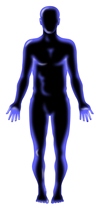Severs Disease
Achilles problems can occur at any age but may be more prevalent amongst people who play sport and in overweight individuals, and can occur in the elderly population as well.
Pain is local to the Achilles tendon and is more frequently medial on the tendon.
The Achilles tendon is the common tendon of the Gastrocnemius and Soleus muscles, and transmits load from these muscles to the calcaneus. The insertion is protected by two bursa, the subcutaneous bursa located between the skin and the tendon and the retro-calcaneal bursa, lying between the tendon and the calcaneus.
The entire tendon is surrounded by a filmy layer of transparent aerolar tissue, the paratenon. The paratenon functions as an elastic sleeve allowing free movement against the surrounding structures.
The Achilles tendon receives its blood supply at three locations, the musculo-tendonous junction, the tendo-osseus junction and through the paratenon. The primary blood supply is through the paratenon with blood vessels entering transversely and running parallel with the fascicles. Studies have shown poor blood supply of the Achilles tendon 2-6cm above the insertion and the common site of rupture and inflammatory lesions is in this area or relative avascularity.
Tendon tissue has a very low metabolic rate, essential for its function if carrying loads and remaining in tension for long periods without the risk of ischeamia. However, the inevitable drawback of this low metabolic rate is in the slow rate of healing after an injury.
Symptoms can be aggravated by
- Weight bearing activities associated with propulsion such as walking, running and stairs.
- In an athlete it may require extreme exertion to create symptoms.
Symptoms ease with
- Rest and reduced activity.
- Decreased toe-off in gait.
Patterns can follow
- Usually sore first thing in the morning with initial weight bearing but eases off although can worsen again through the day or with increased activity.
Achilles problems have arisen because
- Varied and can be slow insidious or related to a minor traumatic event.
Other issues that could be contributing
- Tight calf muscles.
- Poor lower limb mechanics.
- Altered level of activity.
Visible Physical Symptoms
- Patients may have localised thickening and swelling.
- The type of swelling will depend on the chronicity.
- Patient may have biomechanical abnormalities.
Limitations/effects of symptoms
- Altered gait.
- Inability to heel raise, jump or hop.
Management / Treatment
- Treatment should address local treatment such as ice, ultrasound, taping, crutches etc as deemed appropriate by the severity of the problem.
- Some patients may need plaster if very severe or at least non weight bearing.
- Correction of any lower limb biomechanical issues should be addressed as well as any muscle imbalances.
- Rehabilitation of the tissue in the form of progressive rehabilitation as the tendon may be degenerative rather than inflammatory.
- Training techniques in athletes may also need to be addressed if the problem is recurrent.
Similar/Related Conditions
- Retro-calcaneal or subcutaneous bursitis.
- Tibialis Posterior Tendinitis.
- EIP in the lower leg
- Severs Disease.
- Talo-crural and inferior tibio-fibular joint symptoms.
- Calcaneal exostosis
- Vascular Disease.
- Popliteal Artery Entrapment.
- Pain referral from lumbar spine, nerve root and neuro-meningeal structures.
- Systemic Rheumatic Disease.
Other related problems
1. Paratendinitis
Inflammation of the paratenon which may be acute or chronic. In acute conditions, the paratenon becomes inflamed, oedematous and congested. In chronic conditions, the paratenon becomes chronically inflamed, thickened and fibrotic. In chronic conditions, secondary changes occur within the tendon due to vascular embarrassment as the blood supply to the tendon enters through the paratenon.
2. Tendinitis
Inflammatory changes within the tendon itself due to microtears and leading to localised degeneration of the collagen and subsequent mucinoid degeneration or fibrosis.
3. Paratendinitis with tendinitis
Mixed conditions of the achilles tendon are frequent and there is usually nothing to indicate whether the tendon lesion or the paratenon lesion is the primary, or whether both develop as independent responses to use.
4. Partial Rupture
Tear involving a varying number of fibres of the free portion of the achilles tendon.
Ankle Sprain
© David Bowmaker 2011
This document may not be reproduced without written consent from the author





